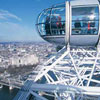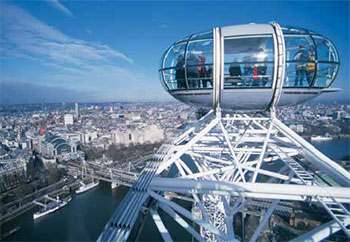
Looking London in the Eye
Thermal imaging finds a way to protect popular British area
- By Chris Maras
- May 01, 2014
 Paris has the Eiffel Tower; New York has the Empire State building;
Sydney has its Opera House; Rome has the Coliseum; and London
has the London Eye, a well-known symbol for an extraordinary
city. Known as the world’s largest cantilevered observation wheel,
the London Eye stands on the south bank of the Thames River
near Westminster Bridge, offering a spectacular way to take in over 55 of London’s
most famous landmarks in just 30 minutes. During this 30-minute flight, up to
800 visitors at a time experience unrivalled views of London on a 135-meter-high,
revolving wheel.
Paris has the Eiffel Tower; New York has the Empire State building;
Sydney has its Opera House; Rome has the Coliseum; and London
has the London Eye, a well-known symbol for an extraordinary
city. Known as the world’s largest cantilevered observation wheel,
the London Eye stands on the south bank of the Thames River
near Westminster Bridge, offering a spectacular way to take in over 55 of London’s
most famous landmarks in just 30 minutes. During this 30-minute flight, up to
800 visitors at a time experience unrivalled views of London on a 135-meter-high,
revolving wheel.
Since opening in 2000, 3.75 million visitors have enjoyed London’s favorite attraction
each year, proving it more popular than renowned historical landmarks
such as St. Paul’s Cathedral—2 million per year—and even more popular than
some internationally renowned tourist attractions. As far as visits are concerned,
the London Eye receives more visitors annually than the Taj Mahal in India—2.4
million per year; Stonehenge in the U.K.—850,000 per year; and even the Great
Pyramids of Giza in Egypt—3 million per year.
The London Eye welcomed its 30 millionth visitor in June 2008. This milestone
in visitor numbers ranks this Thames-side observation wheel alongside some of
the world’s most famous attractions, proving it is as popular as some of the seven
wonders of the world. The attraction has won 75 major awards for design, engineering,
customer care and services to tourism.
Security is a Priority
Since opening, and even during construction, security measures have been extremely
tight at the London Eye. Today, the Merlin Entertainments Group, soleowner
of the London Eye that owns 51 attractions in 12 countries, takes security
seriously. It is of the utmost importance that visitors of the London Eye are safe
and secure not only during their flight, but while waiting, as well.
On New Year’s Eve in 2008, nearly 700,000 people headed to traditional firework
locations, including The London Eye, for displays organized by the mayor of
London. A tight security network needed to be in place.
All passengers aboard the London Eye are thoroughly screened at security,
while security staff keeps an eye on all visitors waiting in line to board each capsule.
In a control room, security staff monitors the images coming in from CCTV
cameras that are installed at multiple locations.
Numerous other security measures, not all visible to visitors, are in place, since
safety and security is the biggest priority for this high-profile attraction.
A Safe Site, Day and Night
The Merlin Entertainments Group wanted to increase security for visitors to a
maximum level.
“Our job is to make sure that the London Eye is an extremely safe place, day
and night,” said Eric Dench, security manager at the London Eye. “If something
unusual happens, we want to know this immediately. Security staff guards the site
continuously, and people in a control room look at the images produced by numerous
cameras around the perimeter. We have also installed a video analytics
system.”
The London Eye is a technically-challenging environment in which to operate
an effective security system because it is a revolving structure, located over a tidal
river with large amounts of reflective glass. The requirement to monitor securitysensitive
areas continuously while keeping the London Eye open for business compounds
these issues.
“If you are underneath the wheel, the likelihood is that you are a tourist or
legitimate operative. But, if anyone attempts to access the structure without authorization,
the security staff needs to be alerted straightaway,” Dench said.
Thermal Imaging Tightens the Security Network
Thermal imaging cameras create a clear image in the darkest of nights. They need
no light whatsoever to operate during the night, but they are also well suited for
daytime use. Since they can see through light fog and rain, smoke and many other
obscurants, they allow this site to be continuously monitored, regardless of changing
environmental conditions.
“Although not always visible to the public, security measures have always been
extremely tight,” Dench said. “We are, however, constantly looking at new and
better ways to make our security network even tighter than it is. A new tool for us
at the London Eye is thermal imaging cameras.”
The core of the thermal imaging cameras that are installed at the London Eye
is FLIR Systems Photons. Equipped with a 320 x 240 pixel Vanadium Oxide detector,
they produce a crisp thermal image on which the smallest of details can be
seen. Furthermore, since they contain an uncooled detector, they are maintenance
free, which is a main advantage when they are installed in hard-to-reach areas.
Thermal Imaging and Video Analytics
Working Closely Together
The images produced by the thermal imaging cameras are not only being watched
by security staff. In order to eliminate human errors, they are also combined with
video analytics. Reliable intrusion detection is based on the ability of a system to
discriminate between background activity and unusual events that require investigation
by guards. The software installed by Ipsotec, combined with the thermal
images delivered by the FLIR Systems, do this job.
“Thanks to thermal imaging, the London Eye became even
safer than before,” Dench said. “Visitors of this major attraction
can be assured that everything is in place to guarantee them a
first-class and safe experience.”
This article originally appeared in the May 2014 issue of Security Today.